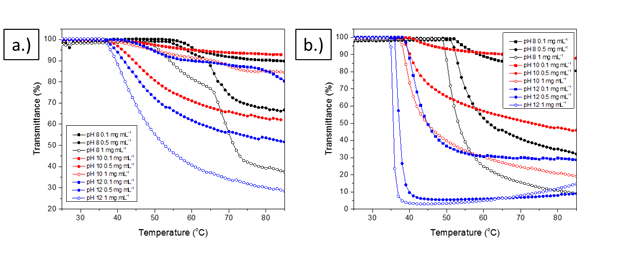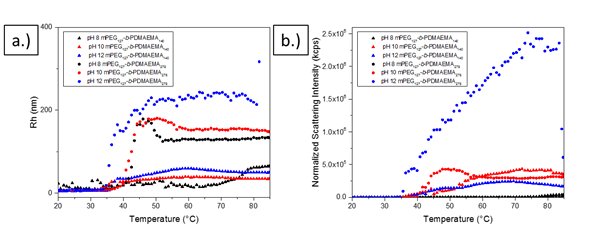Reports: UNI754467-UNI7: Designing "Smart" Polymer Self-Assembling Systems by Tuning Polymer Functionality and Architecture
Elizabeth M. Glogowski, PhD, University of Wisconsin - Eau Claire
Introduction and Goals
Stimuli-responsive polymers, or polymers that dramatically change properties in response to an external stimulus, such as temperature or pH, are of great interest for applications ranging from biomedical and drug delivery applications to smart coatings and nanocomposites. Controlling the structure of the polymers directly impacts the stimuli-responsive properties. The diblock copolymer polyethylene glycol-block-poly((2-dimethylamino)ethyl methacrylate) or PEG-b-PDMAEMA is a double hydrophilic diblock copolymer that changes water solubility as a function temperature, pH, polymer composition, and polymer concentration. At low temperature and low pH, the PEG-b-PDMAEMA diblock copolymers are water soluble. Upon increasing pH and temperature, the diblock copolymers become water insoluble; this is measured as the cloud point. With changing solubility, the polymers can self-assemble into micelles or larger polymer aggregates, as illustrated in Figure 1.
Figure 1. Thermoresponsive self-assembly of PEG-b-PDMAEMA diblock copolymers to form either polymer micelles or larger polymer aggregates.
Results Progress
mPEG-b-PDMAEMA diblock copolymers with controlled molecular weight for both the mPEG block and the PDMAEMA block were synthesized using mPEG precursor with DP of ~127 to prepare mPEG-Br macroinitiator for atom transfer radical polymerization (ATRP) as shown in Scheme 1. This macroinitiator was used to synthesize mPEG-b-PDMAEMA diblock copolymers with controlled PDMAEMA molecular weight in order to determine the effect of both mPEG and PDMAEMA molecular weight on stimuli-responsive properties. These diblock compositions were selected because the thermoresponsive properties have not been previously reported for higher molecular weight compositions as a function of pH, composition, and polymer concentration. Changing pH, polymer composition, and polymer concentration each had an observed effect on the diblock copolymer solubility in aqueous buffered solutions. Two diblock copolymer compositions were studied: mPEG127-b-PDMAEMA140 and mPEG127-b-PDMAEMA278.
Scheme 1:
The cloud point was determined as a function of pH, polymer composition, and polymer concentration by measuring transmittance as a function of temperature at 500 nm using UV-Vis spectroscopy. Diblock copolymer solutions in pH 8, 10, or 12 aqueous buffers were prepared at concentrations of 0.1, 0.5, and 1 mg/mL. The results are shown in Figure 2. The transmittance starts at 100% when the solution temperature is below the cloud point, and once the cloud point is reached, the transmittance dramatically decreases. Cloud point can be calculated from this drop in transmittance for each diblock copolymer solution. Polymer composition, pH, and polymer concentration were each determined to affect the measured cloud point. pH has the greatest impact on cloud point; as pH is increased from 8 to 10 to 12, the cloud point decreases from 50-60°C for pH 8 to 35-45°C for pH 10 and 12 solutions. Changing the PDMAEMA molecular weight increases the cloud point compared to lower molecular weight mPEG-b-PDMAEMA diblock copolymers, but does not have a significant effect on the two compositions reported here. Increasing polymer concentration decreases cloud point between 2 and 6°C depending on pH.
Figure 2. Transmittance data for a) mPEG127-b-PDMAEMA140 and b) mPEG127-b-PDMAEMA278 at 0.1, 0.5, and 1 mg/mL in pH 8 (squares), pH 10 (circles), or pH 12 (open triangles) aqueous buffered solutions.
Dynamic light scattering was used to determine the size of the diblock copolymer assemblies in aqueous buffered solutions. The average hydrodynamic radius was determined from cumulants analysis. Normalized scattering intensity was measured, which corresponds to the average count rate of the DLS data. Figure 3 shows the DLS results for 1 mg/mL mPEG-b-PDMAEMA diblock copolymers as a function of polymer composition and pH. For all tested samples, the average hydrodynamic radius is small at low temperatures, indicating that the polymer chains are molecularly dissolved. The normalized scattering intensity is also low; this indicates the polymer solutions are below the cloud point. With an increase in temperature, once the cloud point is reached, the average hydrodynamic radius and the normalized scattering intensity increase, indicating polymer aggregation. For the shorter PDMAEMA, this aggregate size corresponds to micelles, while the larger mPEG-b-PDMAEMA diblock copolymers form larger polymer aggregates. The pH determines at what temperature micelles or aggregates form; as pH increases, the cloud point decreases.
Figure 3. a) Hydrodynamic radius based on cumulants analysis from dynamic light scattering and b) normalized scattering intensity data from dynamic light scattering for 1 mg/mL pH 8, 10, and 12 aqueous buffered solutions of mPEG127-b-PDMAEMA140 and mPEG127-b-PDMAEMA278.
Personnel Impacts
Funding of this grant provided summer salary support for the PI, as well as salaries for two undergraduate researchers. The undergraduates were able to work full-time during the summer and part-time during the academic year thanks to this financial support, enabling significant progress on the smart polymer synthesis and characterization. The results have been submitted for publication, and will be used as the foundational results for new proposals submitted to the NSF and state of Wisconsin grants to support research.
This funding has provided excellent undergraduate research opportunities that have prepared the participating students for national scholarship competitions, presentations at regional and national conferences, and ultimately graduate school in polymer science and chemistry.















